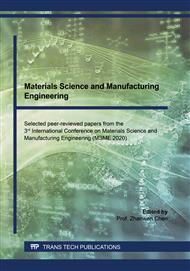[1]
D. Ulutan, T. Ozel, Machining induced surface integrity in titanium and nickel alloys: A review, International Journal of Machine Tools and Manufacture, 51 (2011) 250-280.
DOI: 10.1016/j.ijmachtools.2010.11.003
Google Scholar
[2]
F. Prinz, L. Weiss, C. Amon, J. Beuth, Processing, thermal and mechanical issues in shape deposition manufacturing, in: 1995 International Solid Freeform Fabrication Symposium, (1995).
Google Scholar
[3]
W. Du, Q. Bai, B. Zhang, Machining characteristics of 18Ni-300 steel in additive/subtractive hybrid manufacturing, The International Journal of Advanced Manufacturing Technology, 95 (2018) 2509-2519.
DOI: 10.1007/s00170-017-1364-0
Google Scholar
[4]
S. Li, B. Zhang, Q. Bai, Effect of temperature buildup on milling forces in additive/subtractive hybrid manufacturing of Ti-6Al-4V, The International Journal of Advanced Manufacturing Technology, 107 (2020) 4191-4200.
DOI: 10.1007/s00170-020-05309-7
Google Scholar
[5]
W. Du, Q. Bai, B. Zhang, A Novel Method for Additive/Subtractive Hybrid Manufacturing of Metallic Parts, Procedia Manufacturing, 5 (2016) 1018-1030.
DOI: 10.1016/j.promfg.2016.08.067
Google Scholar
[6]
L. Chen, T.Y. Lau, K. Tang, Manufacturability analysis and process planning for additive and subtractive hybrid manufacturing of Quasi-rotational parts with columnar features, Computer-Aided Design, 118 (2020) 102759.
DOI: 10.1016/j.cad.2019.102759
Google Scholar
[7]
A. Mahammod Hassan, M.T. Havajneh, Statistical analysis of the effects of machining parameters and workpiece hardness on the surface finish of machined medium carbon steel, Journal of Materials Engineering and Performance, 10 (2001) 282-289.
DOI: 10.1361/105994901770344999
Google Scholar
[8]
W. Chen, Cutting forces and surface finish when machining medium hardness steel using CBN tools, International Journal of Machine Tools and Manufacture, 40 (2000) 455-466.
DOI: 10.1016/s0890-6955(99)00011-5
Google Scholar
[9]
J.M. Zhou, V. Bushlya, R.L. Peng, S. Johansson, P. Avdovic, J.E. Stahl, Effects of Tool Wear on Subsurface Deformation of Nickel-based Superalloy, Procedia Engineering, 19 (2011) 407-413.
DOI: 10.1016/j.proeng.2011.11.133
Google Scholar
[10]
R. M'Saoubi, T. Larsson, J. Outeiro, Y. Guo, S. Suslov, C. Saldana, S. Chandrasekar, Surface integrity analysis of machined Inconel 718 over multiple length scales, CIRP Annals, 61 (2012) 99-102.
DOI: 10.1016/j.cirp.2012.03.058
Google Scholar
[11]
M. Imran, P.T. Mativenga, A. Gholinia, P.J. Withers, Comparison of tool wear mechanisms and surface integrity for dry and wet micro-drilling of nickel-base superalloys, International Journal of Machine Tools and Manufacture, 76 (2014) 49-60.
DOI: 10.1016/j.ijmachtools.2013.10.002
Google Scholar
[12]
X. Liang, Z. Liu, Experimental investigations on effects of tool flank wear on surface integrity during orthogonal dry cutting of Ti-6Al-4V, The International Journal of Advanced Manufacturing Technology, 93 (2017) 1617-1626.
DOI: 10.1007/s00170-017-0654-x
Google Scholar


